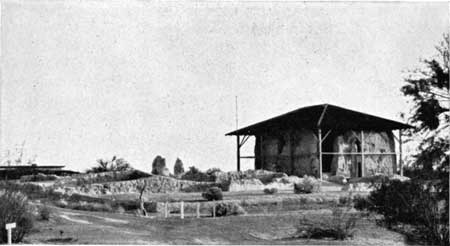![]()
MENU
|
Glimpses of Our National Monuments CASA GRANDE NATIONAL MONUMENT |

The Casa Grande and near-by ruins.
Grant Photo.
The Casa Grande National Monument established to preserve interesting prehistoric ruins, is an area of 472.5 acres of typical desert land, covered with mesquite, creosote, and salt bush, located in the Gila Valley of south central Arizona at an altitude of 1,422 feet.
The Casa Grande, or "Great House," the main feature of this monument, is a burnt-out, dismantled group of solid adobe walls, ruins of a great building which at one time was four stories in height.
The standing walls are 4 feet thick at their base. The first recorded white man to visit the ruin was Father Eusebio Francisco Kino, founder of the Tumacacori Mission, who passed here in 1694 and wrote a description of the ruins, which at the time of his discovery must have been standing for over two centuries in about the same condition that they are to-day. In addition to the great building there are many ruins of other prehistoric dwellings, the whole indicating a remarkable record of advancement in the architecture of the builders at Casa Grande up to the time of its final abandonment.
This area was first established as a national reservation by Executive order of June 22, 1892, under authority contained in the act of Congress approved March 2, 1889, and was classified as a national park. Later, on December 10, 1909, the boundaries of the reservation were changed by the elimination of 120 acres on which there were no prehistoric ruins and the inclusion of a tract of 120 acres adjoining the reservation on the east, on which are located important mounds of historic interest. Finally, on August 3, 1918, by presidential proclamation the reservation was given national monument status.
The history of the rise and fall of the civilization which built and inhabited the Casa Grande ruins is only conjectural but the ruins themselves present much interesting material to the student. Undoubtedly when these people came into the valley they were nomads, but the opportunities for a settled life devoted to agricultural pursuits must have appealed to them. Their first step was the construction of an irrigation system, the remains of which are still plainly visible. Then came the problem of housing and finally the need of defensive construction for protection from their enemies. The multistory house, of which the Casa Grande is the highest development, was probably evolved as a defensive measure. As a watch-tower, it must have proved a good investment, for from its top a guard could cover the country within a radius of 10 miles. This was a great advantage, for if the enemy could be sighted at 10 miles, he, being on foot—the horse was not yet on the American Continent—would need nearly two hours to get to the village, which gave time to get runners out into the fields and gather forces for the defense.
When the valley people were at their most prosperous stage there were probably between 8,000 and 15,000 of them in the Gila and Salt River Valleys. They farmed extensively, raising cotton and corn, made baskets and pottery of a good quality, used stone, wood, and bone tools, used sea shells for decorations and ceremonies, and in general may be said to have lived in the late stages of the Stone Age. No useful metal implements have been found.
It is probable that raiding Apaches became too strong for the valley dwellers, and year after year they lost a larger percentage of their crops and a larger number of warriors than they could afford to lose, until they at last decided to abandon the country. This began possibly 700 or 800 years ago. The improvement in wall construction, as indicated by the ruins, was probably developed over a period of not less than 1,200 years, so that the beginning of this civilization may antedate Christianity.
The national monument can be visited from the Casa Grande station on the Southern Pacific Railroad, 22 miles away, or from Coolidge, which is on the new Southern Pacific Line between Tucson and Phoenix and is 2-1/2 miles from the monument. Accommodations and cars for the trip may be had at either place. Motorists traveling the Old Spanish Trail and Bankhead Highway between Tucson and Phoenix leave the highway at the town of Florence, going southwest to the monument. Frank Pinkley, superintendent of southwestern national monuments, is in immediate charge of the Casa Grande National Monument and maintains his permanent headquarters at this point. His post office address is Coolidge, Ariz.
|
|
Last Modified: Thurs, Oct 19 2000 10:00:00 pm PDT
glimpses2/glimpses4.htm

 Top
Top